Source-YouTube
Yellow jacket stings are a common occurrence, especially during the warmer months when these aggressive insects are most active. While yellow jackets play an essential role in ecosystems as pollinators and scavengers, their stings can cause pain, swelling, and in some cases, severe allergic reactions. This comprehensive guide aims to provide valuable insights into yellow jacket stings, including their symptoms, treatment options, and effective prevention strategies.
Understanding Yellow Jacket Stings
Yellow jackets are a type of wasp belonging to the Vespidae family. They are identifiable by their black and yellow striped bodies and are known for their aggressive behavior when defending their nests. Unlike bees, which can only sting once before dying, yellow jackets can sting multiple times, making them particularly formidable.
Behavior and Habitat
Yellow jackets build nests in various locations, including underground burrows, hollow trees, and wall voids. Their nests can house thousands of individuals, and disturbing them can provoke defensive attacks. Yellow jackets are attracted to sugary foods, meats, and other protein sources, making outdoor gatherings and picnics prime targets for encounters.
Sting Mechanism
When a yellow jacket stings, it injects venom into the victim through its stinger, which can cause a range of reactions depending on the individual’s sensitivity and the number of stings received. The venom contains proteins and chemicals that trigger pain, inflammation, and allergic responses in some people.
Symptoms of Yellow Jacket Stings:

Yellow jacket stings can elicit various reactions, ranging from mild discomfort to severe allergic reactions. Common symptoms include:
1. Pain and Swelling
Immediately after being stung, individuals may experience pain, redness, and swelling at the site of the sting. The intensity of pain and swelling can vary depending on factors such as the location of the sting and the individual’s sensitivity.
2. Itching and Redness
The area around the sting may become itchy and develop redness as a result of the body’s inflammatory response to the venom.
3. Localized Reactions
Most yellow jacket stings result in localized reactions confined to the area of the sting. These reactions typically resolve within a few hours to a few days without complications.
4. Systemic Reactions
In some cases, individuals may experience systemic reactions to yellow jacket stings, characterized by symptoms such as:
- Hives
- Difficulty Breathing
- Swelling of the Face, Throat, or Tongue
- Dizziness or Lightheadedness
- Nausea and Vomiting
Systemic reactions indicate an allergic response to the venom and require immediate medical attention.
5. Anaphylaxis
Anaphylaxis is a severe and potentially life-threatening allergic reaction that can occur within minutes of a yellow jacket sting. Symptoms of anaphylaxis include:
- Difficulty Breathing
- Drop in Blood Pressure
- Loss of Consciousness
Anaphylaxis is a medical emergency and requires immediate treatment with epinephrine.
Treatment Options for Yellow Jacket Stings:
Prompt and appropriate treatment is essential for managing yellow jacket stings and alleviating symptoms. Depending on the severity of the reaction, treatment options may include:
1. Removing the Stinger
If a yellow jacket stinger is embedded in the skin, it should be removed as soon as possible to prevent further venom injection. The stinger can be scraped off using a blunt object such as a credit card.
2. Cleaning the Area
After removing the stinger, wash the affected area with soap and water to reduce the risk of infection.
3. Applying Cold Compresses
Applying a cold compress or ice pack to the sting site can help reduce pain, swelling, and itching.
4. Counter Pain Relievers

Over-the-counter pain relievers such as ibuprofen or acetaminophen can help alleviate pain and reduce inflammation. Antihistamines may also be helpful for relieving itching and redness.
5. Topical Steroids
Topical corticosteroid creams or ointments can help reduce inflammation and itching associated with yellow jacket stings.
6. Seeking Medical Attention
For severe reactions, such as systemic symptoms or signs of anaphylaxis, seek immediate medical attention. Treatment may involve the administration of epinephrine, corticosteroids, or antihistamines to manage symptoms.
Preventing Yellow Jacket Stings:
Preventing yellow jacket stings is essential, especially for individuals who are allergic to insect venom. Here are some effective prevention strategies:
1. Avoiding Nests
Be cautious around areas where yellow jackets are likely to build nests, such as under eaves, in shrubs, or near garbage cans.
2. Covering Food and Beverages
When dining outdoors, keep food and beverages covered to avoid attracting yellow jackets.
3. Wearing Protective Clothing
Wear light-colored clothing and avoid wearing strong scents or perfumes that may attract yellow jackets. When spending time outdoors, especially in areas where yellow jackets are prevalent, consider wearing long sleeves, pants, and closed-toe shoes.
4. Using Insect Repellents

Apply insect repellents containing DEET or picaridin to exposed skin and clothing to deter yellow jackets.
5. Remaining Calm and Still
If approached by a yellow jacket, remain calm and still to avoid provoking an attack. Do not swat at the insect, as this may increase the likelihood of being stung.
6. Inspecting Outdoor Spaces
Regularly inspect outdoor spaces, such as decks, sheds, and play structures, for signs of yellow jacket activity and nests. If a nest is found, contact a professional pest control service for safe removal.
7. Educating Children
Teach children about the dangers of yellow jackets and how to avoid being stung. Encourage them to remain calm and still if approached by a yellow jacket and to notify an adult if they encounter a nest.
Conclusion
Yellow jacket stings can be painful and, in some cases, pose a serious health risk, especially for individuals who are allergic to insect venom. Understanding the symptoms of yellow jacket stings, knowing how to properly treat them, and implementing effective prevention strategies are essential for minimizing the risk of encounters and mitigating the impact of stings.
By following simple precautions and staying informed, individuals can enjoy outdoor activities safely and reduce the likelihood of yellow jacket stings. Remember, if you experience a severe reaction to a yellow jacket sting or signs of anaphylaxis, seek immediate medical attention for proper evaluation and treatment. Stay vigilant, stay prepared, and stay safe from yellow jacket stings.
Explore More on The Lifesciences Magazine







